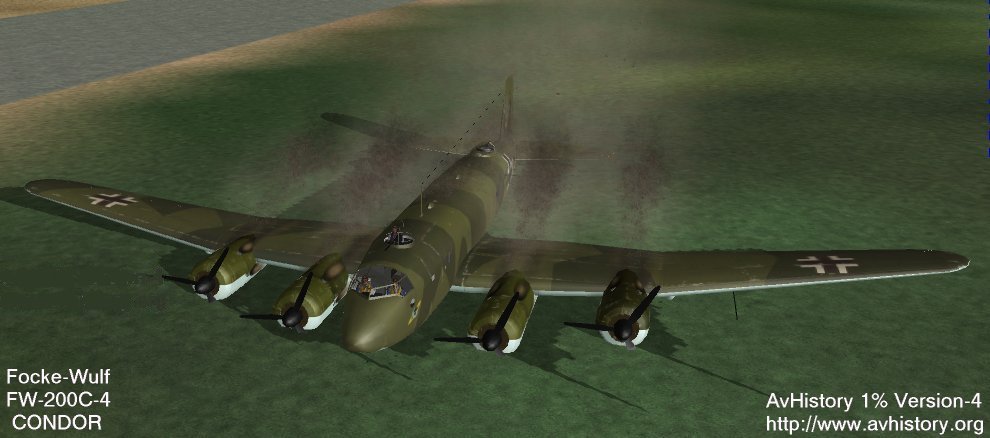Gregory Pierson's Version 4.0 first released in August 2006 represents a complete update of the AvHistory 1% Assembly Line Process (1%ALP). Compared to our previous efforts, 4.0 is an order of magnitude improvement and a closer step towards our goal of producing aircraft that perform within 1% of the real aircraft. For additional info on Version-4 flight packages see the included AvHistory - Version-4 1%ALP text file.
AIRCRAFT BACKGROUND:
Groundcrew Design Group's Greg Law created this outstanding visual and John (BRAVO/4) Whelan painted it as the maritime patrol craft F8+AH flown the 1st Staffel, Kampfgeschwader 40 based at Bordeaux-Merignac, Western France.

This unit carried out maritime patrols over the Atlantic in the period June-August 1940, under the operational control of Marine Gruppe West, at Lorient. The Fw200 was developed in the late 1930's as a commercial transport for the German airline Lufthansa. The aircraft set a number of long distance flight records, and based on a Japanese request in 1938, Focke-Wulf modified the aircraft to create a maritime reconnaissance bomber. The first production model, the C-1 version, entered service with the Luftwaffe in June 1940 at Bordeaux-Merignac.

The Fw200 earned its reputation as the "Scourge of the Atlantic" with the sinking of significant numbers of Allied ships as well as coordinating attacks with the German U-Boats.
Typically, Condors flew long missions between France and Norway; a flight would take off from Bordeaux-Merignac on the French coast, loop far out into the Atlantic until well west of Ireland, and then turn north and east before landing at Trondheim-Vaernes in Norway; a fresh crew would fly a return the next day.
Though a Luftwaffe asset, the Condors functioned under the operational control of the U-boat command, locating and radioing the position of convoys to lurking submarines, and then undertaking their own attacks as well. (Occasionally, in a turnabout, U-boats would locate a convoy, report its position, and then shadow it for subsequent air and sub attacks). In one six-month period, the Condors of one maritime patrol bomber wing, Kampfgeschwader 40, assisted by some smaller He 111's, destroyed 85 ships totaling 363,000 tons.

As a rule, Condors were highly successful "ship-busters;" in one attack against a 16-ship convoy off England in February 1941, five FW 200



